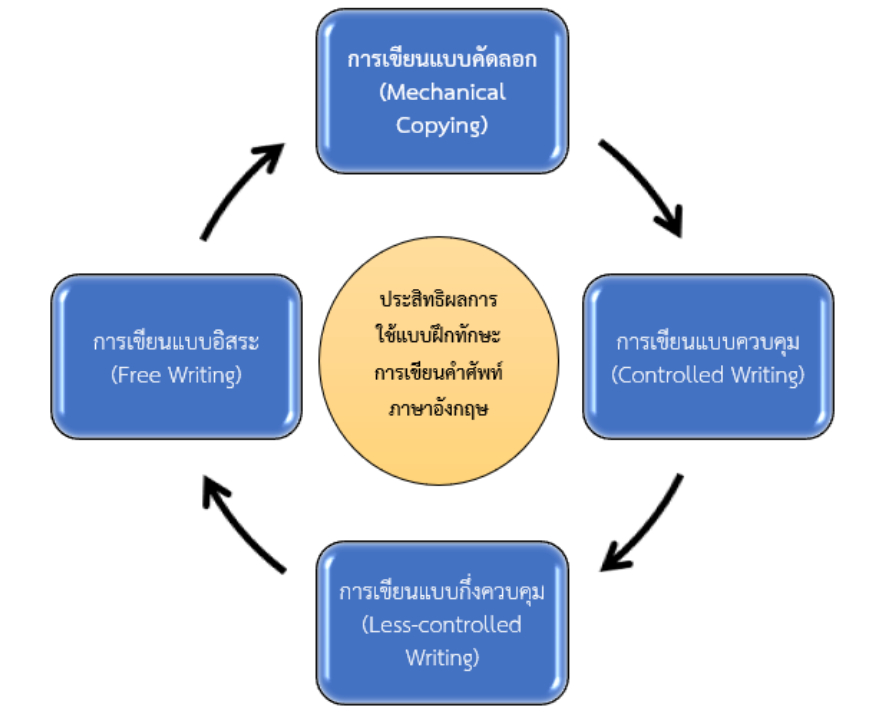การพัฒนาแบบฝึกทักษะการเขียนคำศัพท์ภาษาอังกฤษ สำหรับนักเรียนชั้นประถมศึกษาปีที่ 6
Main Article Content
บทคัดย่อ
การวิจัยครั้งนี้ มีวัตถุประสงค์เพื่อพัฒนาแบบฝึกทักษะการเขียนคำศัพท์ภาษาอังกฤษ สำหรับนักเรียนชั้นประถมศึกษาปีที่ 6 ให้มีประสิทธิภาพตามเกณฑ์ 75/75 และมีค่าดัชนีประสิทธิผลตั้งแต่ 0.50 ขึ้นไป เพื่อเปรียบเทียบผลสัมฤทธิ์ทางการเขียนคำศัพท์ภาษาอังกฤษก่อนและหลังเรียนด้วยแบบฝึกทักษะการเขียนคำศัพท์ภาษาอังกฤษ และเพื่อศึกษาความพึงพอใจของนักเรียนที่มีต่อการเรียนด้วยแบบฝึกทักษะการเขียนคำศัพท์ภาษาอังกฤษ กลุ่มตัวอย่างในการวิจัยครั้งนี้คือ นักเรียนชั้นประถมศึกษาปีที่ 6 ภาคเรียนที่ 1 ปี
การศึกษา 2565 โรงเรียนคูคำพิทยาสรรพ์ สำนักงานเขตพื้นที่การศึกษาขอนแก่น เขต 4 จำนวน 19 คน ซึ่งได้มาโดยการเลือกแบบเจาะจง เครื่องมือที่ใช้ในการวิจัย ได้แก่ แบบฝึกทักษะการเขียนคำศัพท์ภาษาอังกฤษสำหรับนักเรียนชั้นประถมศึกษาปีที่ 6 แผนการจัดการเรียนรู้ สาระการเรียนรู้ภาษาอังกฤษ ชั้นประถมศึกษาปีที่ 6 จำนวน 5 แผน เวลา 15 ชั่วโมง แบบทดสอบวัดผลสัมฤทธิ์ทางการเขียนคำศัพท์ภาษาอังกฤษ เป็นแบบเลือกตอบ 4ตัวเลือกและแบบอัตนัยเขียนตอบจำนวน 40 ข้อ ซึ่งมีค่าความยากง่าย .40 -.67 มีค่าอำนาจจำแนก .56 -.97 ค่าความเชื่อมั่นทั้งฉบับเท่ากับ .85 และแบบสอบถามความพึงพอใจของนักเรียนที่มีต่อการเรียนภาษาอังกฤษโดยใช้แบบฝึกทักษะการเขียนคำศัพท์ภาษาอังกฤษ สถิติที่ใช้ในการวิเคราะห์ข้อมูล ได้แก่ ความเที่ยงตรง ค่าความยากง่าย ค่าอำนาจจำแนก ค่าความเชื่อมั่นค่าร้อยละ ค่าเฉลี่ย ส่วนเบี่ยงเบนมาตรฐาน และทดสอบค่าที ผลการวิจัย พบว่า แบบฝึกทักษะการเขียนคำศัพท์ภาษาอังกฤษที่ผู้วิจัยสร้างขึ้น มีประสิทธิภาพเท่ากับ 78.13/82.11 ซึ่งสูงกว่าเกณฑ์ที่กำหนดไว้ 75/75และค่าดัชนีประสิทธิผลเท่ากับ .74 นักเรียนที่เรียน โดยใช้แบบฝึกทักษะการเขียนคำศัพท์ภาษาอังกฤษมีผลสัมฤทธิ์ทางการเขียนคำศัพท์หลังเรียนสูงกว่าก่อนเรียนอย่างมีนัยสำคัญทางสถิติที่ระดับ .01 และมีความพึงพอใจต่อการเรียนภาษาอังกฤษโดยใช้แบบฝึกทักษะการ
เขียนคำศัพท์ภาษาอังกฤษโดยภาพรวมอยู่ในระดับมากที่สุด
Article Details
เอกสารอ้างอิง
ชัชรีย์ บุนนาค. (2564). 4 อุปสรรคเรียนรู้ภาษาเด็กไทยต้องปรับแก้ตั้งแต่สอนจนถึงสอบ.
https://www.bangkokbiznews.com/news/detail/865612
ชัยยงค์ พรหมวงศ์. (2556). การทดสอบการทดสอบประสิทธิภาพสื่อหรือชุดการสอน. วารสารศิลปากรศึกษาศาสตรวิจัย, 5(1), 7-19.
ธวัชชัย นามวงศ์ษา. (2562). การพัฒนาทักษะการเขียนภาษาอังกฤษของนักเรียนชั้นประถมศึกษาปีที่ 6 โรงเรียนอนุบาลเชียงคาน “ปทุมมาสงเคราะห์” สำนักงานเขตพื้นที่การศกึษาประถมศึกษาเลยเขต 1 โดยใช้แบบฝึกทักษะการเขียนภาษาอังกฤษ. วิทยานิพนธ์ปริญญาศิลปศาสตรบัณณฑิต สาขาวิชาภาษาอังกฤษศึกษา มหาวิทยาลัยราชภัฎเลย.
นันทนัช ทองคำดี. (2565). การพัฒนาชุดแบบฝึกทักษะการอ่านภาษาอังกฤษเพื่อความเข้าใจโดยการเรียนแบบ MIA (Murdoch) ของนักเรียนชั้นประถมศึกษาปีที่ 6 โรงเรียนวัดกลางวงศ์มณีจังหวัดพิจิตร. การค้นคว้าอิสระหลักสูตรการศึกษามหาบัณฑิต สาขาวิชาภาษาอังกฤษ มหาวิทยาลัยนเรศวร.
บุศรินทร์ เดชดำรงค์ปรีชา. (2564). การพัฒนาทักษะการเขียนภาษาอังกฤษด้วยขั้นตอนการเขียนของบรู๊คส์และวิทโธร ของนักศึกษามหาวิทยาลัย. มหาวิทยาลัยเทคโนโลยีราชมงคลกรุงเทพ, file:///C:/Users/DELL/Downloads/Busarin_2019%20(1).pdf
ปววิศร์ ปิงเมือง และประกอบ กรณีกิจ. (2565). ผลของการจัดการเรียนรู้ด้วยโมไบล์แอปพลิเคชันช่วยการเรียนภาษาที่ใช้ภาระงานเป็นฐานและเกมิฟิเคชันเพื่อส่งเสริมทักษะการเขียนภาษาอังกฤษของนักเรียนมัธยมศึกษาตอนต้น. วารสารเทคโนโลยีและสื่อสารการศึกษา, 17(22), 104-123.
พรธณา เจือจารย์. (2560). การพัฒนาผลสัมฤทธิ์ทางการเรียนโดยใช้ชุดฝึกทักษะเรื่องการใช้เครื่องมือโปรแกรม Microsoft Word 2016 วิชาคอมพิวเตอร์ในงานธุรกิจ สำหรับนักศึกษา ระดับประกาศนียบัตรวิชาชีพชั้นปีที่ 3 สาขาวิชาคอมพิวเตอร์ธุรกิจ. กรุงเทพฯ: สำนักงานคณะกรรมการ
ส่งเสริมการศึกษาเอกชน กระทรวงศึกษาธิการ.พันทิวา ลาคำ. (2555). การพัฒนาแบบฝึกทักษะการเขียนภาษาอังกฤษตามแนวการสอนเพื่อการสื่อสาร กลุ่มสาระการเรียนรู้ภาษาต่างประเทศ สำหรับนักเรียนชั้นประถมศึกษาปีที่ 6. วิทยานิพนธ์ปริญญาครุศาสตรมหาบัณฑิต สาขาวิชาการพัฒนาหลักสูตรและการเรียนการสอน มหาวิทยาลัยราชภัฎอุบลราชธานี.
วิไลพรรณ สุรินทร์ธรรม และ นิธิดา อดิภัทรนันท์. (2563). การจัดการเรียนรู้ที่เน้นปัญหาเป็นฐานเพื่อส่งเสริมความสามารถในการเขียนภาษาอังกฤษและการเรียนอังกฤษด้วยตนเองของนักเรียนชั้นมัธยมศึกษาปีที่ 5. วารสารศึกษาศาสตร์ มหาวิทยาลัยนเรศวร. 22(2), 169-181.
สถาบันทดสอบทางการศึกษาแห่งชาติ. (2564). จำนวนและร้อยละของนักเรียนตามช่วงคะแนนผลการสอบ O-NET ปีการศึกษา 2563. http://www.newonetresult.niets.or.th/
อัญชลี แจ็คสัน. (2561). การพัฒนาทักษะการเขียนประโยคภาษาอังกฤษของนักเรียนชั้นประถมศึกษาปีที่ 6 โรงเรียนบ้านดงน้อย อำเภอผาขาว จังหวัดเลย โดยใช้แบบฝึกทักษะการเขียนเกี่ยวกับภาพ. วิทยานิพนธ์ปริญญาศิลปศาสตรบัณณฑิต สาขาวิชาภาษาอังกฤษศึกษา มหาวิทยาลัยราชภัฎเลย.
Arapoff, N. (1975). Writing a thinking Process. English Teaching Forum 13 (March-May): 233-237.
Edmonds, W, A., and Kennedy, T, D. (2017). An Applied Guide to Research Designs: Quantitative, Qualitative, and Mixed Methods. California: Sage.Education First. (2020). EF English Proficiency Index. 9th ed. https://www.ef.com/wwen/epi/
Haris, D. P. (1969). Teaching English as a Second Language. New York: McGraw- Hill Book Company.
Lado, L. (1964). Language Teaching. London: McGraw-Hill Book Company.
Szecsy, E. M. (2008). Four-Skills Language Learning Theory. In (pp. 313-314). SAGE Publications, Inc.
White, R.V. (1980). Teaching Written English. London: George Allen &Unwin


